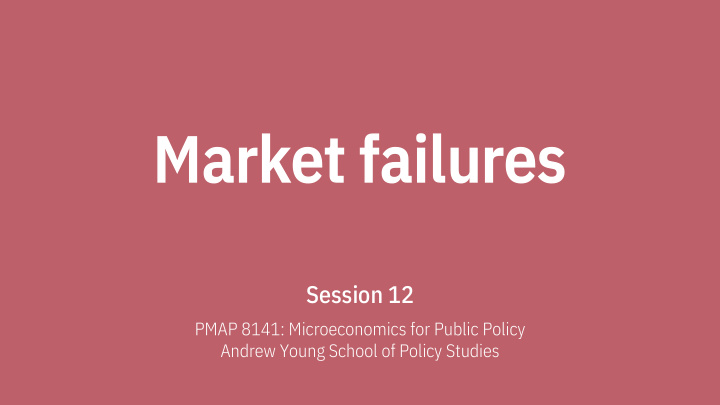



Ma Mark rket et f failures ures Session 12 PMAP 8141: Microeconomics for Public Policy Andrew Young School of Policy Studies
Plan for today Institutions, markets, and prices Public goods External effects Addressing external effects
Institutions, markets, and prices
What is a market? An institution used for organizing society “A way of connecting people who may mutually benefit by exchanging goods or services through a process of buying and selling.”
Prices are messages “When markets work well, prices send messages about the real scarcity of goods and services” Prices coordinate activity and behavior among complete strangers
When prices do not capture the effects of individual actions, markets fail Public goods Externalities Monopolies Missing markets Asymmetric information
Public goods
Private goods Excludable You can stop people from using it Rival You using it makes it so others can’t use it
Public goods Non-excludable You can’t stop people from using it Non-rival You using it doesn’t make it so others can’t use it
Public goods Excludable Not excludable Private Common Pool Rival goods/bads Resources Club Public Not rival goods goods/bads
Rivalry and excludability A free public lecture held at a university Noise produced by aircraft around an airport A forest used by the community to collect firewood A public park Hamilton tickets Bird/Lime/Uber scooters
Public goods are tricky Public goods are underprovided Public goods are a multi-party game theory dilemma Free riding and hare hunting Public goods are positive externalities
External effects
External effects (aka externalities) A cost or benefit to someone who did not choose that cost or benefit Social marginal cost/benefit
Examples Pollution Vaccinations Cell phones and driving Internet bandwidth Research Education
Positive production effects SMC below MC Basic research NSF, NIH, NEA
Negative production effects SMC above MC Pollution
Positive consumption effects SMB above MB Vaccines
Negative consumption effects SMB below MB International airline travel
Equity and fairness issues
Addressing external effects
General problem with externalities Someone isn’t paying enough
Solution to all externality problems Internalize the externality Make SMC/SMB part of the equation so that the price fully reflects the external costs and benefits of a party’s actions
Private sector solutions Public sector solutions Market-ish solutions
Private sector solutions Merging and acquiring Natural governance Coasian bargaining
Merging and acquiring The polluting firm buys the downstream firm (or vice versa) What gets internalized?
Natural governance Buyers or producers fix and govern the externality on their own (invisible hand) What gets internalized?
Coasian bargaining Use private property + negotiations to fix everything Ronald Coase
Coasian bargaining
Coasian bargaining Coase Theorem part #1 Property rights + bargaining = everything is fixed Coase Theorem part #2 It doesn’t matter who has the property rights
Who should pay? Person reclining or person behind them?
Who should pay? Person reclining or person behind them? Parking lot owners or drivers? Factories or fishermen? Government or downwinders?
Who should pay? Is the “polluter pays” principle fair?
But there are problems… Assignment Who gets blamed and who pays? Holdouts Free riders One person can veto Individuals will underinvest Transaction costs Negotiations are hard and costly
Coasian bargaining Great for small-scale, localized externalities that are trackable Good luck fixing global climate change or curing cancer
Public sector solutions Regulations Pigouvian taxation Pigouvian subsidies
Regulations Use laws to limit Q Shift MC ↑ to SMC Reduce Q and DWL
Pigouvian taxation Arthur Pigou Tax amount of damage Shift MC ↑ to SMC Reduce Q and DWL
Pigouvian subsidies Pay amount of benefit Shift MC ↓ to SMC Increase Q and social surplus
But there are problems… Harm hard to measure Who is hurt the most? Costs hard to measure How much does the damage cost society? Power and politics Powerful can make powerless pay
Market-ish solutions Caps + tradable permits
Government issues 200 permits to allow for 1 unit of pollution Plants A and B each get 100 permits It’s cheaper for A to abate pollution, so they don’t need as many permits B will buy permits from A until they have 150 and 50 each Pollution goes down while maintaining flexibility
Regional Greenhouse Gas Initiative (RGGI) Western Climate Initiative (WCI)
EU Emissions Trading Scheme American Clean Energy and Security Act of 2009
But there are problems… Reduce damage now, consequences be damned vs. Minimize costs Quantity regulations get the right level of reduction, but it can be way expensive and can distort markets Cap and trade keeps costs down, but doesn’t guarantee level of abatement
Which is best? Private sector solutions Public sector solutions Market-ish solutions lol No perfect solution
Recommend
More recommend